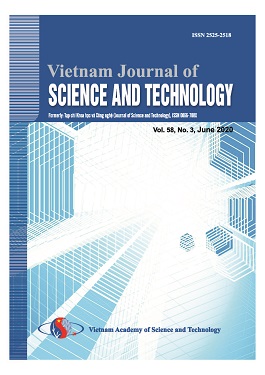ANTIMICROBIAL EFFECT OF TURMERIC OIL (CURCUMA LONGAL.)
Author affiliations
DOI:
https://doi.org/10.15625/0866-708X/48/5/1193Abstract
Essential oil was extracted from turmeric rhizome by steam distillation and it’s composition was determined by GC-MS method. In total, 36 volatile compounds were identified and 13 of them had ≥90% identity with reference compounds. The main constituent of obtained turmeric oil was ar-turmerone (30.33%), followed by alpha-turmerone (14.14%). The antimicrobial activity of turmeric oil was evaluated by observing microbial growth on solid medium supplementing with different concentration of oil. The result showed that Gram positive bacteria were more sensitive to the oil than Gram (-) bacteria. B. cereuswas inhibited at 1%, while L. damsellalost it’s growth at essential oil concentration 3%only. The test-fungi exhibit different sensitivity to turmeric oil. The most resistant was MNh14 (Aspergillus sydowi) and MNh19 (Aspergillus japonicus) isolated from Litchi chinensis, these strains can tolerate 4% of oil in growth medium.
Considering the importance of essential oils as ecofriendly agents, and their antimicrobial activity, the essential oils have potential as environmentally safe alternatives and as components in integrated pest management programs.
Keywords. Curcuma longa, hydrodistillation, microbial activity, essential oil, turmeric rhizome.
Downloads
Downloads
Published
How to Cite
Issue
Section
License
Vietnam Journal of Sciences and Technology (VJST) is an open access and peer-reviewed journal. All academic publications could be made free to read and downloaded for everyone. In addition, articles are published under term of the Creative Commons Attribution-ShareAlike 4.0 International (CC BY-SA) Licence which permits use, distribution and reproduction in any medium, provided the original work is properly cited & ShareAlike terms followed.
Copyright on any research article published in VJST is retained by the respective author(s), without restrictions. Authors grant VAST Journals System a license to publish the article and identify itself as the original publisher. Upon author(s) by giving permission to VJST either via VJST journal portal or other channel to publish their research work in VJST agrees to all the terms and conditions of https://creativecommons.org/licenses/by-sa/4.0/ License and terms & condition set by VJST.
Authors have the responsibility of to secure all necessary copyright permissions for the use of 3rd-party materials in their manuscript.







 Vietnam Journal of Science and Technology (VJST) is pleased to notice:
Vietnam Journal of Science and Technology (VJST) is pleased to notice: